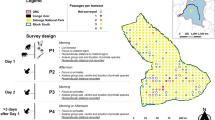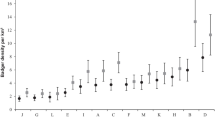Abstract
Density estimates are a common tool for assessing potential changes in primate populations over time and for evaluating important habitat characteristics such as preferred food sources. There are several different methods for estimating the density and population of wild primates, though the accuracy of these methods across different habitats and species is difficult to assess. We calculated the density of the population of Müller’s gibbon (Hylobates muelleri) in the pristine and regenerating forest in Sungai Wain Protection Forest in East Kalimantan, Indonesia from May to July 2012. We collected data on the location of bonded pairs and compared the results of two different density estimate methods: triangulation and point transect sampling using Distance software. The triangulation method yielded population estimates of 486.9 ± SD 132.6 individuals in the pristine forest and 274.3 ± SD 179.0 in the regenerating forest. Distance analysis produced population estimates of 580.5 ± CV 20.6 and 388.4 ± CV 23.4 individuals for the pristine and regenerating forest, respectively. The difference in the density estimates between methods was not significant. We hypothesize that point transect sampling overestimated group density based on the unusually high estimate, but further investigation into the accuracy of point transect analysis using Distance with respect to gibbons is needed. We conclude that triangulation remains an important tool for hylobatid surveys because of its efficacy in locating gibbon groups using acoustic detection.




Similar content being viewed by others
References
Akaike, H. (1973). Information theory and an extension of the maximum likelihood principle. In B. N. Petran & F. Csàaki (Eds.), International symposium on information theory (pp. 267–281). Budapest: Akadèemiai Kiadi.
Badan Meteorologi Klimatologi dan Geofisika. (2015). Badan Meteorologi Klimatologi dan Geofisika. Retrieved from: http://www.bmkg.go.id/BMKG_Pusat/
Bennett, E., Caldecott, J., Kavanagh, M., & Sebastian, A. (1987). Current status of primates in Sarawak. Primate Conservation, 8, 184–186.
Bersacola, E., Ehlers Smith, D. A., Sastramidjaja, W. J., Rayadin, Y., & Cheyne, S. M. (2014). Population density of Presbytis rubicunda in a small primary dipterocarp forest in East Kalimantan, Indonesian Borneo. Asian Primates Journal, 4(2), 16–26.
Brockelman, W. Y., & Ali, R. (1987). Methods of surveying and sampling forest primate populations. In R. A. Mittermeier & C. W. Walsh (Eds.), Primate conservation in the tropical rainforest (pp. 23–62). New York: Alan R. Liss.
Brockelman, W. Y., & Srikosamatara, S. (1993). Estimation of density of gibbon groups by use of loud songs. American Journal of Primatology, 29, 93–108.
Buckland, S. T. (2006). Point transect surveys for songbirds: robust methodologies. The Auk, 123, 345–357.
Buckland, R. A., Anderson, D. R., Burnham, K. P., Laake, J. L., Borschers, D., & Thomas, L. (2001). Introduction to distance sampling: Estimating abundance of biological populations. Oxford: Oxford University Press.
Buckley, C., Nekaris, K. A. I., & Husson, S. J. (2006). Survey of Hylobates agilis albibarbis in a logged peat-swamp forest: Sabangau catchment, Central Kalimantan. Primates, 47, 327–335.
Buckland, S. T., Plumptre, A. J., Thomas, L., & Rexstad, E. (2010a). Design and analysis of line transect surveys for primates. International Journal of Primatology, 31, 833–847.
Buckland, S. T., Plumptre, A. J., Thomas, L., & Rexstad, E. (2010b). Line transect sampling of primates: Can animal-to-observer distance methods work? International Journal of Primatology, 31, 485–499.
Cheyne, S. M. (2008). Effects of meteorology, astronomical variables, location and human disturbance on the singing apes: Hylobates albibarbis. American Journal of Primatology, 70, 386–392.
Cheyne, S. M., Thompson, C. J. H., Phillips, A. C., Hill, R. M. C., & Limin, S. H. (2008). Density and population estimate of gibbons (Hylobates albibarbis) in the Sabangau catchment, Central Kalimantan, Indonesia. Primates, 49, 50–56.
Cheyne, S. M., Zrust, M., Hoeing, A., Houlihan, P. R., Rowland, D., Rahmania, M., & Breslin, K. (2012). Barito River initiative for nature conservation and communities (BRINCC) preliminary report. BRINCC Expedition Reports (pp. 1–74). Palangka Raya: BRINCC Expedition.
Chivers, D. J. (1984). Feeding and ranging in gibbons: A summary. In H. Preuschoft, D. J. Chivers, W. Y. Brockleman, & N. Creel (Eds.), The lesser apes: Evolutionary and behavioural biology (pp. 267–281). Edinburgh: Edinburgh University Press.
Chivers, D., Anandam, M., Groves, C., Molur, S., Rawson, B., Richardson, M., Roos, C., & Whittaker, D. (2013). Family Hylobatidae (gibbons). In R. A. Mittermeier, A. B. Rylands, & D. Wilson (Eds.), Handbook of the mammals of the world, Vol. 3: Primates (pp. 754–791). Barcelona: Lynx Edicions.
Cleary, D. F. R., & Priadjati, A. (2005). Vegetation responses to burning in a rain forest in Borneo. Plant Ecology, 177, 145–163.
Fredriksson, G. M., & Nijman, V. (2004). Habitat use and conservation status of two elusive ground birds (Carpococcyx radiates and Polyplectron schleiermacheri) in the Sungai Wain Protection Forest, East Kalimantan, Indonesian Borneo. Oryx, 38, 297–303.
Fuentes, A. (2000). Hylobatid communities: Changing views on pair bonding and social organization in hominoids. American Journal of Physical Anthropology, 31, 33–60.
Geissman, T. (2007). Status reassessment of the gibbons: results of the Asian Primate Red List workshop 2006. Gibbon Journal, 3, 5–15.
Haimoff, E. H. (1985). The organization of song in Müller’s gibbon (Hylobates muelleri). International Journal of Primatology, 6, 173–192.
Hamard, M., Cheyne, S. M., & Nijman, V. (2010). Vegetation correlates of gibbon density in the peat-swamp forest of the Sabangau Catchment, Central Kalimantan, Indonesia. American Journal of Primatology, 72, 607–616.
Harrison, R. D. (2011). Emptying the forest: Hunting and the extirpation of wildlife from tropical nature reserves. BioScience, 61, 919–924.
Hassel-Finnegan, H. M., Borries, C., Larney, E., Umponjan, M., & Koenig, A. (2008). How reliable are density estimates for diurnal primates? International Journal of Primatology, 29(5), 1175–1187.
Höing, A., Quinten, M. C., Indrawati, Y. M., Cheyne, S. M., & Waltert, M. (2013). Line transect and triangulation surveys provide reliable estimate of the density of Kloss’ gibbons (Hylobates klossii) on Siberut Island, Indonesia. International Journal of Primatology, 34, 148–156.
Hutan Lindung Sungai Wain. (2015). Pengelolaan HLSW. Retrieved from: http://sungaiwain.org/profil-hlsw/pengelolaan-hlsw
IUCN. (2013). The IUCN Red List of Threatened Species v. 2013.1. Retrieved from: Http://www.iucnredlist.org.
Lee, D. C., Powell, V. J., & Lindsell, J. A. (2015). The conservation value of degraded forests for agile gibbons Hylobates agilis. American Journal of Primatology, 77(1), 76–85.
Leighton, D. R. (1987). Gibbons: Territoriality and monogamy. In B. B. Smuts (Ed.), Primate societies (pp. 135–145). Chicago: University of Chicago Press.
Lindsell, J., Klop, E., & Siaka, A. M. (2011). The impact of civil war on forest wildlife in West Africa: Mammals in Gola Forest, Sierra Leone. Oryx, 45(1), 69–77.
Maples, E. G., Haraway, M. M., & Collie, L. (1988). Interactive singing of a male Mueller’s gibbon with a simulated neighbor. Zoo Biology, 7, 115–122.
Marshall, A. J. (2009). Are montane forests demographic sinks for Bornean white-bearded gibbons Hylobates albibarbis? Biotropica, 41, 257–267.
Mitani, J. C. (1990). Demography of agile gibbons (Hylobates agilis). International Journal of Primatology, 11, 411–424.
Mittermeier, R. A., Myers, N., Thomsen, J. B., da Fonseca, G. A. B., & Olivieri, S. (1998). Biodiversity hotspots and major tropical wilderness areas: Approaches to setting conservation priorities. Society for Conservation Biology, 12, 516–520.
Mukherjee, R. P. (1986). The ecology of the Hoolock gibbon, H. hoolock, in Tripura, India. In J. G. Else & P. C. Lee (Eds.), Primate ecology and conservation (pp. 115–123). Cambridge, U.K.: Cambridge University Press.
Neilson, E., Nijman, V., & Nekaris, K. A. I. (2013). Conservation assessments of arboreal mammals in difficult terrain: Occupancy modeling of pileated gibbons (Hylobates pileatus). International Journal of Primatology, 34, 823–835.
Nijman, V. (2001). Effect of behavioural changes due to habitat disturbance on density estimation of rain forest vertebrates, as illustrated by gibbons (Primates: Hylobatidae). In H. H. de Longh & P. J. M. Hillegers (Eds.), The balance between biodiversity conservation and sustainable use of tropical rain forests (pp. 217–225). Wageningen, the Netherlands: Tropenbos International.
Nijman, V. (2004). Conservation of the Javan gibbon Hylobates moloch: Population estimates, local extinctions, and conservation priorities. Raffles Bulletin of Zoology, 52, 271–280.
Nijman, V., & Menken, S. B. J. (2005). Assessment of census techniques for estimating density and biomass of gibbon (Primates: Hylobatidae). Raffles Bulletin of Zoology, 53, 201–211.
O’Brien, T. G., Kinnaird, M. F., Nurchayo, A., Iqbal, M., & Rusmanto, M. (2004). Abundance and distribution of sympatric gibbons in a threatened Sumatran rain forest. International Journal of Primatology, 25, 267–284.
Phoonjampa, R., Koenig, A., Brockleman, W. Y., Borries, C., Gale, G. A., Carroll, J. P., & Savini, T. (2011). Pileated gibbon density in relation to habitat characteristics and post-logging forest recovery. Biotropica, 43, 619–627.
Plumptre, A. J. (2000). Monitoring mammal populations with line transect techniques in African forests. Journal of Applied Ecology, 37(2), 356–368.
Plumptre, A. J., & Cox, D. (2006). Counting primates for conservation: Primate surveys in Uganda. Primates, 47(1), 65–73.
Rawson, B. M. (2010). The use and abuse of gibbon survey techniques: Shortcomings of auditory survey techniques. In T. Nadler, B. M. Rawson, & V. N. Thinh (Eds.), Conservation of primates in Indochina (pp. 253–258). Hanoi: Frankfurt Zoological Society and Conservation International.
Reichard, U. (1998). Slee** sites, slee** places, and presleep behavior of gibbons (Hylobates lar). American Journal of Primatology, 62, 35–62.
Robbins, D., Chapman, C. A., & Wrangham, R. W. (1991). Group size and stability: Why do gibbons and spider monkeys differ? Primates, 32, 301–305.
Rodman, P. S. (1978). Diets, densities and distributions of Bornean primates. In G. G. Montgomery (Ed.), The ecology of arboreal primates. Washington, DC: Smithsonian Institute Press.
Russon, A. E. (2009). Orangutan rehabilitation and reintroduction. In S. A. Wich, S. S. Utami, T. Mitra Setia, & C. P. van Schaik (Eds.), Orangutans: Geographic variation in behavioral ecology and conservation (pp. 327–350). Oxford: Oxford University Press.
Suzuki, A. (1992). The population of orang-utans and other nonhuman primates and the forest conditions after the 1982–83’s fires and droughts in Kutai National Park, East Kalimantan, Indonesia. In G. Ismail, M. Mohamed, & S. Omar (Eds.), Forest biology and conservation in Borneo (pp. 190–205). Yayasan Sabah: Kota Kinabalu.
Thomas, L., Buckland, S. T., Rexstad, E., Laake, J. L., Strindberg, S., Hedley, S. L., Bishop, J.R.B., Marques, T.A., & Burnham, K.P. (2010). Distance software: Design and analysis of distance sampling surveys for estimating population size. The Journal of Applied Ecology, 47, 5–14.
Wilson, C. C., & Wilson, W. L. (1975). The influence of selective logging on primates and some other animals in East Kalimantan. Folia Primatologica, 23, 245–274.
Acknowledgments
We thank the Indonesian State Ministry of Research and Technology for granting permission to conduct research in Sungai Wain Protection Forest. This project was funded by AZA Ape TAG and Les Vallée des Singes. We gratefully acknowledge Pak Agus, Wiwit Sasatramidjaja, and local Sungai Wain Protection Forest staff and students for their help with logistics and data collection. We thank Dr. Gabriella Fredriksson for her valuable knowledge on the history of Sungai Wain Protection Forest. We thank Drs. Thad Bartlett, Warren Brockleman, Marina Cords, David Lee, Joanna Setchell, Carl Traeholt, and five anonymous reviewers for their comments on previous drafts of the manuscript. The manuscript was greatly improved through the numerous discussions on gibbon conservation and survey methods at the 25th Congress of the International Primatological Society. We also thank Hellen Bersacola, Dr. David Ehlers Smith, Dr. Eric Rexstad, and Danica Stark for their assistance with distance analysis and map design. This research was conducted with the approval of Oxford Brookes University and in accordance with the British Sociological Association.
Author information
Authors and Affiliations
Corresponding author
Rights and permissions
About this article
Cite this article
Gilhooly, L.J., Rayadin, Y. & Cheyne, S.M. A Comparison of Hylobatid Survey Methods Using Triangulation on Müller’s Gibbon (Hylobates muelleri) in Sungai Wain Protection Forest, East Kalimantan, Indonesia. Int J Primatol 36, 567–582 (2015). https://doi.org/10.1007/s10764-015-9845-1
Received:
Accepted:
Published:
Issue Date:
DOI: https://doi.org/10.1007/s10764-015-9845-1




